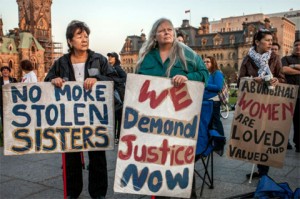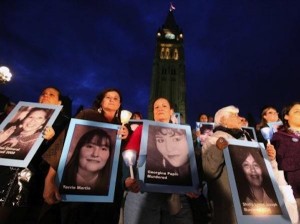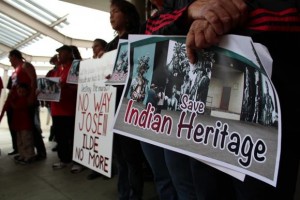As Sara Baartman’s case showed us, indigenous women have been objectified, appropriated, and fetishized since the beginning of colonialism in order to justify the conquering of “lesser” people. One of the biggest weapons used against native people during colonization was sexual violence against women. Since the aboriginals were viewed for the most part as “dirty” and “without god” any violence done toward them didn’t count because they weren’t fully human. Indigenous women all over the world were taken and abused since the beginning of westward conquest, a trend that we can still see playing out in today’s world, but many of this stories were never publicized. Baartman’s story was overly publicized and exploited, but many other involving taken and murdered indigenous women were largely forgotten and unreported- a trend that can still be seen today.
Across North America, particularly we will look at Canada, the effects of these colonialist ideas still permeate how native women are treated and seen in society. Indigenous women are going missing and being murdered at a much higher rate than other women in Canada- a rate so high it constitutes nothing less than a national human rights crisis. Aboriginal women aged 25 to 44 are five times more likely to suffer a violent death than other women in Canada. And yet, these cases often go unreported in the media and are not given the same attention as white women who suffer the same. The media coverage of native women in Canada and the U.S. that is broadcast typically serves to reinforce stereotypes of native women. Kristen Gilchrist, a researcher on native women in media, found that a feeling of “otherness” permeates the coverage on missing and murdered native women, instead of feelings of united outrage and communal togetherness that is present in most stories on similarly situated white women.

Also, the problem is as much in the U.S. as it is in Canada. Studies in the United States have shown that darker-skinned women receive less coverage than white women, but so do women who are at higher risk for violence such as sex trade workers, women living in poverty and those with drug addictions. Scholars call this bias, which divides victims into stereotypes of pure women who are newsworthy victims and fallen women who are not, “missing White woman syndrome.” This goes back to reflect the ideas that certain women, especially indigenous women, are un-pure and therefore fine to abuse.

The Canadian government’s lack of response to this human rights crisis is setting the tone that they do not care about aboriginal women and their lives. Groups all around Canada are calling for an end to this human rights crisis and are calling for change. They are saying that it is not longer acceptable to not pay attention to native women and to not view them as equal members of society. The colonialist ideas around the bodies of aboriginal women will no longer be acceptable and they will not tolerate a lack of publicity. Racist and sexist stereotypes deny the dignity and worth of Indigenous women, encouraging some men to feel they can get away with violent acts of hatred against them, but with an increase in media coverage publicizing this as unacceptable, this might help decrease the violence against native women.
Additional Readings:
http://indiancountrytodaymedianetwork.com/2015/03/31/another-international-call-inquiry-murdered-and-missing-indigenous-women-canada-159828
http://mediasmarts.ca/diversity-media/aboriginal-people/media-portrayals-missing-and-murdered-aboriginal-women
Sources:
http://mediasmarts.ca/diversity-media/aboriginal-people/media-portrayals-missing-and-murdered-aboriginal-women
http://www.rcmp-grc.gc.ca/pubs/mmaw-faapd-eng.pdf
https://intercontinentalcry.org/colonialism-genocide-and-gender-violence-indigenous-women/
https://www.facebook.com/pages/Missing-Murdered-Aboriginal-Women-in-Canada/313160025391260


